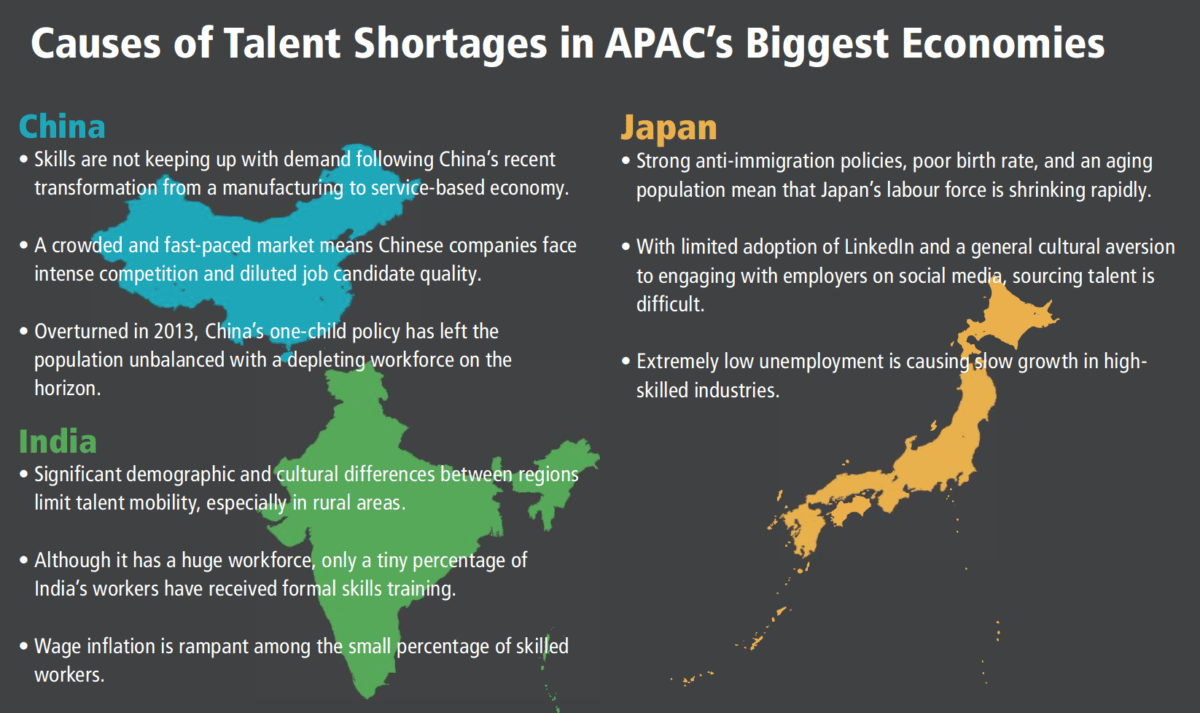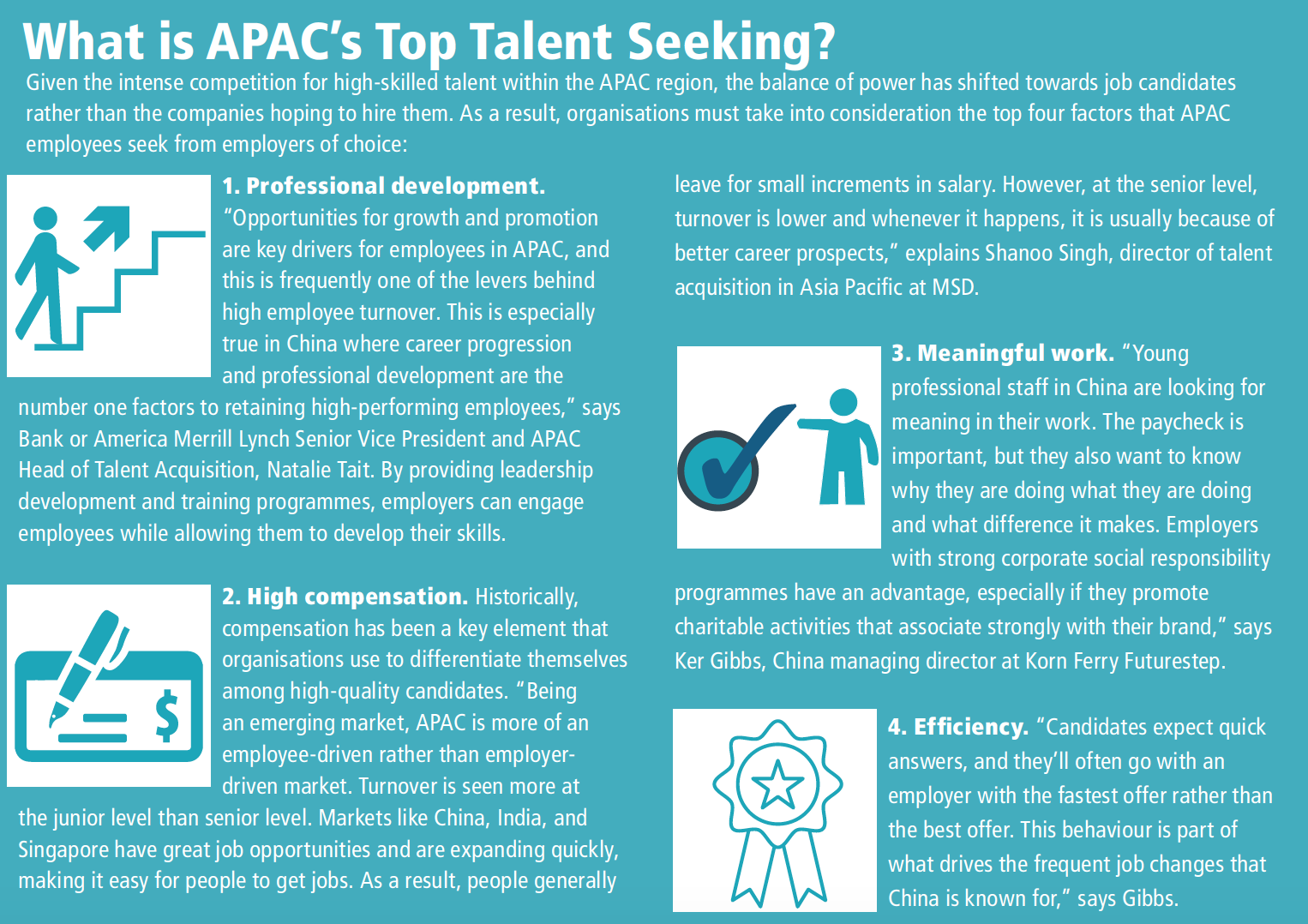Organisations in Asia are adapting to stay competitive in a tough talent market.
By Marta Chmielowicz
The Asia-Pacific region is home to 4.5 billion people – nearly 60 per cent of the world’s population. Consisting of five countries that rank amongst the top 15 largest economies in the world -China, Japan, India, South Korea, and Australia -and featuring a robust annual GDP growth of 5.5 per cent in 2017, the region presents some of the best opportunities for business expansion and growth.
However, whilst the dynamic, diverse, and highly entrepreneurial nature of APAC countries make them a key driver of the global economy, these same qualities present unique challenges to organisations operating in the region. Faced with wide cultural diversity; varying levels of political, economic, and infrastructural maturity; and profound talent shortages throughout the region, businesses that wish to succeed in APAC need to adopt new strategies to take advantage of this area’s many opportunities.
Contending with Talent Shortages
As the economies of countries that make up the APAC region continue to grow and become increasingly modern, more and more companies are seeking to break into the market and expand their existing operations. However, these organisations face the risk of crippling challenges sourcing, recruiting, and retaining talent.
According to Caleb Baker, managing director of Asia Pacific and emerging markets at Alexander Mann Solutions, “Changing demographics, technological evolution, and a world prone to political, economic, and social shocks have created a global environment in which talent shortages are the rule rather than the exception.”
These talent shortages are particularly pronounced in the area’s hottest industries. “Many of today’s most sought-after specialties, such as cloud computing and mobile app design, did not exist a decade ago. This disruption is causing a skilled worker deficit in fields like science, technology, engineering, and mathematics and a surplus of low-skilled workers in others, such as administration and manufacturing,” Baker explains.
Although the causes of skilled labour shortages vary across countries, MSD‘s Director of Talent Acquisition in Asia Pacific Shanoo Singh outlines two major contributing factors:
- Inadequate education. According to Singh, “The main causes of talent shortages in the APAC region are education systems that do not make students and young talent immediately employable -hence the need for bridge programmes -and focus on developing technical skills first and leadership skills much later.”
Even when providing technical training, education systems in APAC countries can rarely keep up with market demand.
“Whilst several countries have invested significantly in education for their growing populations, particularly in technology skills, even this influx of new, talented populations isn’t managing to keep pace with demand,” explains Sarah Wong, managing director of Allegis Global Solutions APAC. “Many APAC economies have now become the training ground for leading-edge companies in North America and Europe, creating further shortfalls in talent supply for APAC.”
- Lack of leadership skills. Because leadership skills are not prioritised early on, many of APAC’s job candidates lack the necessary know-how to succeed in high-level management positions. “In terms of leadership skills, the challenges that occur are around the cultural fit of candidates and the ability to work across boundaries in a highly networked world,” says Singh.
Racing for Top Talent
In addition to talent shortages, businesses operating in APAC must also contend with increased competition for talent in an already tight labour pool of qualified candidates. This is particularly true for multinational corporations whose strict salary structures and highly standardised HR processes make it difficult to compete with more flexible local companies.
“Perhaps the biggest talent challenge facing APAC organisations is the move towards process transformation and functional optimisation throughout the HR function,” says Wong. “As APAC matures, the increased lens on cost control and driving efficiencies throughout the region means employers must support more growth with fewer resources than ever before, and do so in an increasingly cutthroat and competitive market for top talent.”
Multinational corporations’ centralised decision-making processes can also deter APAC candidates who value speed in communication and career progression. “Candidates look at career opportunities and sometimes feel they can make more of an impact at a local company where decision-making is faster and can lead to quicker career progression,” says Ker Gibbs, managing director of Korn Ferry Futurestep‘s operations in China.
As a result of this stiff competition, employee turnover in the APAC region was at all all-time high of 30 per cent in 2017, according to International Monetary Foundation’s October 2017 Regional Economic Outlook Update: Asia Pacific -and this trend is only expected to continue.
Keys to Success
How can organisations overcome APAC’s talent shortages? According to Alexander Mann Solutions’ Baker, the answer is adaptability. To succeed in APAC markets, global businesses must have HR processes that are standardised enough to be efficient but flexible enough to adapt to local markets.
“A ‘high impact’ HR model that blends globalised talent practices for consistency and mobility with localised flexibility to attract, retain, and manage people appropriately is crucial,” Baker says. “Global businesses should have a global HR function. At the same time, in order to compete successfully in diverse markets, companies should recruit, train, and manage people locally -reflecting local culture, local labour markets, and the needs of diverse local business units.”
Organisations can also ensure business success by implementing a number of strategies:
- Develop promising talent. One way that organisations can combat APAC’s talent shortages is by tapping into business schools and universities to find and hire promising young talent. “It is important for companies to tap the millennial talent, groom them, and partner with universities and colleges that offer vocational courses around skill development,” says MSD’s Singh.
Businesses also need to evaluate the talent that they already have, provide opportunities for upskilling, and guide their employees into clearly structured leadership pipelines. “Organisations should define and know the talent they need now and five years from now, and design personalised candidate journeys that reflect the preferred behaviours of the target talent. Overall, they need to implement recruitment ‘lanes,’ not processes,” Baker explains.
According to Natalie Tait, senior vice president and APAC head of talent acquisition at Bank of America Merrill Lynch, these measures are essential to increasing employee mobility and retaining talent. “Organisations need to focus effort on learning and development, harnessing new technology to make this more accessible globally,” she says. “Tenure of role and learned skills are reducing, so organisations need to operate with more agility and think about how skills are cycled and recycled across the enterprise so institutional knowledge can be retained and leveraged.”
- Build an attractive employer brand. Organisations can also alleviate recruitment challenges by taking steps to build a comprehensive employee value proposition. It’s no longer enough to provide competitive compensation packages to attract top talent in competitive APAC markets -organisations need to differentiate themselves through employer branding.
“With the endemic of enterprise-wide standardisation and increasingly rigid salary structuring seen at employers throughout APAC, top talent is no longer being won over by huge salary increases or exorbitant pay packages,” says Allegis Global Solutions’ Wong. “This has led HR organisations to stop simply looking to fill roles with qualified candidates and instead to focus on connection and cultural fit as competitive differentiators, underscoring a trend already seen in other global markets.”
In order to demonstrate their brand and value to potential employees, APAC businesses are beginning to turn to technology. In particular, social media platforms are increasingly being used as an alternative to traditional recruitment methods to seek out and engage job candidates.
In China where internet access is restricted, Gibbs believes that WeChat is a convenient way to engage and attract potential candidates. In most other countries, LinkedIn, Facebook, and Twitter are good options.
By allowing employers to effectively build relationships with passive and active candidates instead of simply relying on “post and pray” tactics, establishing a strong social media presence that is targeted to a company’s workforce needs is essential to navigating APAC’s talent gaps.
- Leverage new technologies to improve efficiency. As with other global markets, job seekers in APAC are increasingly attracted to companies with efficient, simple, and interactive recruitment processes. To deliver this type of candidate experience, companies in the APAC region are utilising artificial intelligence and automation in everyday HR activities.
This new generation of recruitment tools can help organisations combat talent shortage problems. According to Baker, “With the screening and administrative process automated, recruiters are able to shift their focus back to being relationship builders -namely, speaking to candidates, connecting them to managers, and guiding company inductions instead of spending a disproportionate amount of time on mundane paperwork. Furthermore, the involvement of the robot can also diminish error rates, eliminate bias, and save time and costs by taking out human fallacy.”
Technologies that improve efficiency in hiring include video interviewing platforms, screening chatbots, job boards with mobile capabilities, and tools that can parse resumes using machine-learning technology.
As a result of adopting such technologies, MSD has seen widespread recruitment success. “The automation of the entire talent acquisition cycle with newer technologies and platforms has allowed us to cut down on transactional activities and be more strategic in our approach. It has enabled us to take talent acquisition as a function to the next level of sophistication and improvement,” says Singh.
However, it is important for organisations to remember that these strategies may not necessarily be one-size-fits-all. “Talent acquisition leaders can’t simply rely on what works in the Western culture as they expand into APAC,” says Baker. “Organisations must understand the different priorities and requirements of APAC talent and adapt if they are to secure and retain the best talent. Organisations with a culture of acknowledging the differences have a greater chance of retaining top talent.”
















